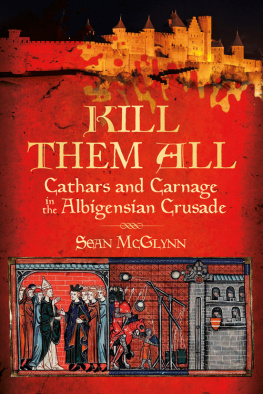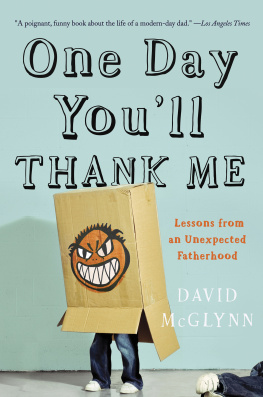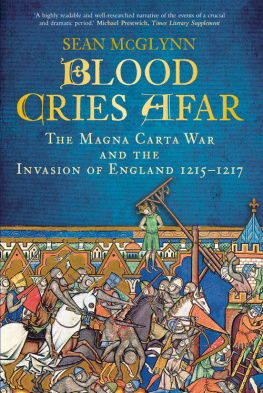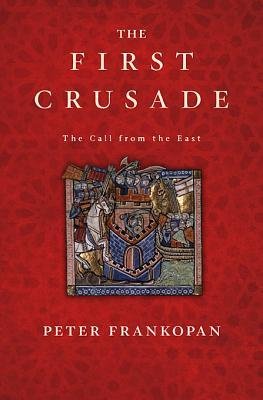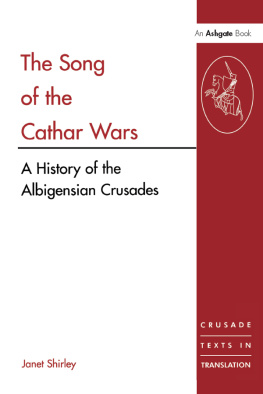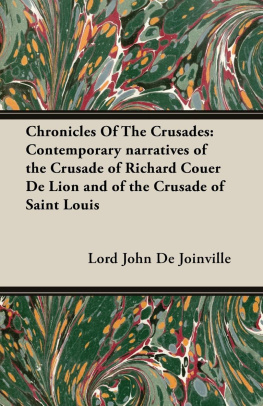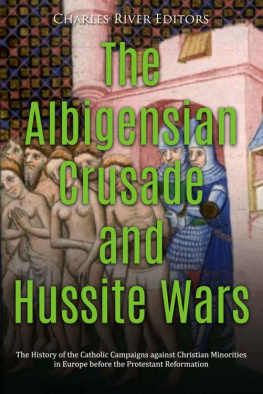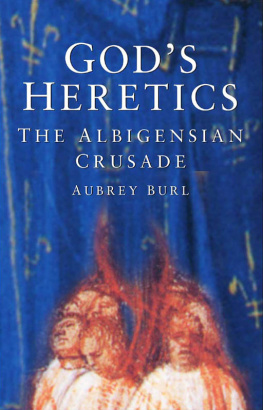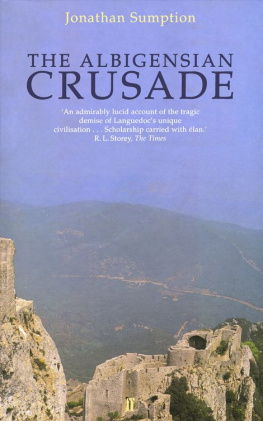

For Joe
D espite this books frequently dark and disturbing content, with all too many parallels with conflicts in the world today, I have enjoyed writing it tremendously. Much of this was owed to getting back to the basics of immersing myself in the main contemporary evidence provided by the four main war reporters of the conflict: Peter of Vaux de Cernay, William of Tudela, the Anonymous and William of Puylaurens. In this regard, I would like express my gratitude and debt to Janet Shirley and Michael Sibly, who, between them (and with Michaels late father, William), have produced the essential English translations and editions of these writers. I have enjoyed and appreciated their support and correspondence while writing this book and I am grateful for their permission to use some plans of medieval towns that first appeared in their works. Some of the other maps are based on a selection from Michel Roqueberts five-volume history in French of the Albigensian Crusade.
There is no doubt that the influences of John Gillingham and John France are present in this book; both remain leading figures in the world of medieval warfare studies. I have enjoyed many discussions at conferences and talks with Paul Webster, Matt Bennett, Dan Power and others, as well as my regular contact with Simon Barton at the University of Exeter. The patience and encouragement of Shaun Barrington at The History Press has again made working with him a pleasure. Mention should also be made of Dirk van Gorp and his editorship of the excellent new magazine Medieval Warfare. Work continues to be stimulating at The Open University and at Plymouth Universitys Strode College, where special thanks go to my colleagues on the History, Heritage and Archaeology degree programme, Andy Pickering and Katherine Dray.
When I first drew up the proposal for this book some years ago, Laurence Marvins excellent The Occitan War: A Military and Political History of the Albigensian Crusade, 12091218 had yet to be published. Both being scholars of medieval warfare, it is inevitable that Prof Marvin and I focus on similar material much of the time and often reach the same conclusions. His book frequently clarified my understanding of some events or alerted me to an alternative reading of others in the chronicles. However, there is also plenty that is dissimilar as we very often present differing interpretations and analysis of aspects of the military episodes for the period 120918. The main difference is that Marvin finishes his account in 1218, while I continue to 1244 to cover all the warfare of the Albigensian Crusade, including the last military episode against the Cathar heretics at Montsgur. I also add a broader introduction to encompass a discussion of heresy and emphasise throughout the wider European picture, especially the role of England; I also seek to explain the warfare of the crusade in light of military practice in medieval Europe. Thus the additional material that these 3540,000 extra words explore makes Kill Them All a different book, the first to offer a military analysis of the whole Albigensian conflict.
On a personal level, I owe much to the ongoing support of friends: Stephen Rigby, Stephen Forrow, Glenn Renshaw, Anthony and Jackie Cross, Mary Beeken, Michael Owen, the Ottaways, Cath Hanley (herself a medieval scholar and also a historical fiction writer) and others. Very special mention goes to my great friend Robert Purves, who accompanied my son Sam and me to Languedoc and who, with Sam, took the majority of the photos in this book bringing back warm memories of a tremendous trip that helped to make the writing of this book so enjoyable.
As always, my love goes to Sam, Maddy and Jenny, and to Marie, who is doing wonderful things and without whom so much would be impossible.
A Note on Names
Medieval names are notoriously flexible in the permutations of their forms. As a general, but far from inviolable, rule, I have anglicised the names of leading protagonists. I have kept the original names of some ecclesiastics such as the legate Arnald Almaric to emphasise their southern origins. Rather than employing the familiar academic use of names and titles in the style of, for example, Raymond Roger Trencavel, Viscount of Carcassonne, I have simplified it to Viscount Raymond Roger of Carcassonne. For the most part, I have retained de for French toponymns (e.g. Bouchard de Marly). Simon de Montfort is simply Montfort. I refer to him predominantly as viscount to emphasise his early territorial position in Languedoc. The French proclivity for hyphenation is not replicated here, hence Pierre des Vaux-de-Cernay becomes Peter of Vaux de Cernay. Castrum and castra are such recurrent terms and constant features of the landscape of the book that I have not italicised them.
C ONTENTS

I NTRODUCTION
J ust over 800 years ago, the brutal Albigensian Crusade began as a war waged initially against the Cathar heretics in southern France. Much has been written about the Cathars, the progress of the crusade and the ultimate suppression of the heresy by the Inquisition but the military history and warfare of the whole crusade has not hitherto received a book-length study.
The emphasis of this book is very much on the incredible drama of the battles and sieges of the crusade and the brutality with which the wars were fought. My intention has been to provide an exciting narrative of the military operations together with expert analysis of strategy and tactics, and an assessment of the leadership of the commanders the famous Viscount Simon de Montfort and the arguably less familiar but equally important Louis the Lion and the Count Raymonds of Toulouse. Other books narratives of the crusade understandably intersperse its progress with politics and religion, but for my purposes this would be detrimental to conveying the intensity and drama of the warfare itself. I deal briefly with religion in the first chapter; important developments in politics are covered as and when they influence the military arena and therefore are discussed in their military context rather than as detailed studies of their own. My focus throughout is on the war, how it was fought and what it tells us about the nature of warfare in the High Middle Ages, making this book the first dedicated military history of the entire Albigensian conflict.
I intend to show that military operations took precedence over all else; religion and politics, vital as they were, depended on the outcome of the battlefield. Ultimately, this was a war not fought simply for religion (as is commonly supposed, even by many academics) but for territorial conquest. Thus, in 1213, at the pivotal battle of Muret, the crusaders under Simon de Montfort took on the forces of King Peter II of Aragn, acknowledged as a champion of the Catholic cause by the papacy. National identity was far more important than religion: in the south, Catholics and Cathars alike united to resist the French, whom they considered to be barbaric northerners. The south fought to preserve its customs, laws and language against the northern invaders and the military occupation of its cities.
The book is structured around chapters which relate pivotal and dramatic military events as well as the overall course of the fighting. The chapter titles are quotes from contemporary sources that reflect phases of the conflict for the period under discussion. These are related and analysed in considerable depth to reveal the tactics and strategy of crusading warfare. The book starts by looking at the origins of the crusade and its logistical preparations before covering its launch and horrific start with the massacre of Bziers and the fall of Carcassonne. The brutal progress of the early years of the war is then charted, marked by many massacres, climaxing with the remarkable battle of Muret in 1213, which saw the death of a king. We then continue with Simon de Montforts ruthless, relentless leadership during a period when the southerners co-ordinated a successful counter-attack, culminating in 121718 with the second (and most significant) siege of Toulouse, a huge military operation that resulted in grievous losses for the northerners. In the period that follows, Louis the Lion, heir to the throne and then King of France, takes up the crusaders cross with a major siege of Avignon, after which the scorched-earth operations of the French saw the land itself and the people who lived off it as the primary target in a period of anarchy. The final chapters examine the last phase of the war no less bloody or less marred by massacre and include important, extremely rare accounts of the siege of Carcassonne in 1240 and the battle of Saintes and Taillebourg in 1242; the latter, though fought outside Languedoc, were decisive in sealing the fate of the Cathars.
Next page
